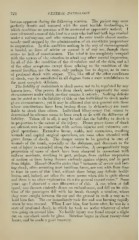Page 714 - My FlipBook
P. 714
724 GENERAL PATHOLOGY.
become apparent during the following reaction. The patient may seem
perfectly frantic and tortured ^vith the most terrible forebodings, in
which condition no question will be answered or apparently noticed. I
once witnessed a case of this kind in a man who had had both legs crushed
under a raihvav-car, and who screamed the same words almost contin-
uously until stopped by the administration of an ansesthetic preparatory
to amputation. In this condition nothing in the way of encouragement
is heeded, no form of advice or counsel is of any use, though there
seems no lack of consciousness. The mind is too completely occupied
with the terrors of the situation to admit any other mental impression.
In all of this the condition of the circulation and of the skill, and all
of the other symptoms except those relating to the condition of the
mental faculties, are the same, only perhaps less in degree, as in cases
of profound shock with stupor. This, like all of the other conditions
of shock, may be manifested in all degrees from a mere watchfulness to
the most complete delirium.
The liability of individuals to sJwck seems not to be regulated by any
known laws. One person dies from shock under apparently the same
circumstances under Mdiich another escapes it entirely. Nothing definite
can be stated as to the liability of this or that individual to shock under
given circumstances yet it may be affirmed that as a general rule those
;
whose constitutions have been broken down by debauchery are more
liable to shock than others. Individual idiosyncrasy that cannot be
determined in advance seems to have much to do with the difference of
liability. Taken all in all, it may be said that the liability to shock is
in proportion to the extent of the injury. Hence grave forms of shock
are oftenest seen in connection with serious injuries and extensive sur-
gical operations. Extensive burns, scalds, and contusions, crushing
wounds and capital surgical operations, are most often attended with
grave forms of shock. The danger seems to be greatest in case of
Avounds of the trunk, especially of the abdomen, and decreases as the
seat of injury is extended along the extremities. A comparatively large
projiortion of cases of shock have been observed in connection with
railway accidents, resulting in part, perhaps, from sudden suspension
of motion or from being thrown violently against objects, and in part
from fright. IVIansel-Moullin states that " instances of severe and last-
ing shock, often assuming most insidious forms, are met with from time
to time in cases of this kind, without there being any definite bodily
lesion, and, indeed, are often tlie more severe when this is quite absent
and there is no other explanation than the general mental cause." Some
years ago I observed a case illustrative of this. A car, when at full
speed, was thrown violently down an embankment, and fell on its side.
One of the passengers fell with his hands through a window, where
they M'cre caught between the car and the ground in such a way as to
hold him fast. The car inunediately took fire and was burning rapidly
when he was rescued. When I saw him, four hours after, he was in a
state of profound shock, in which he took no notice whatever of what
was going on around him. Xo bodily injury was found except a slight
cut on one cheek made by glass. Reaction began in about twenty-four
hours, and he made a good recovery.


